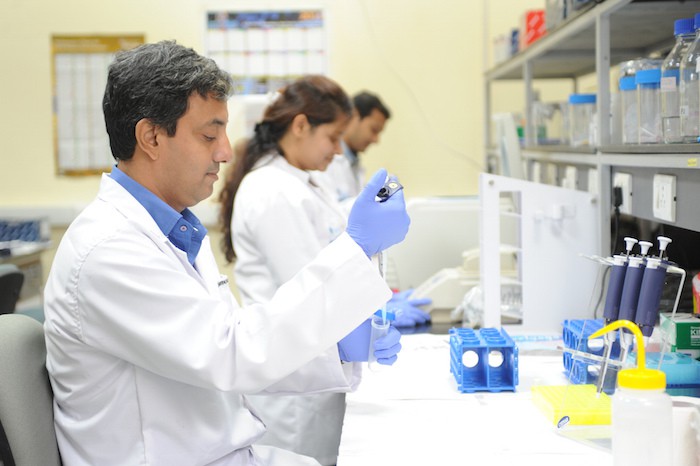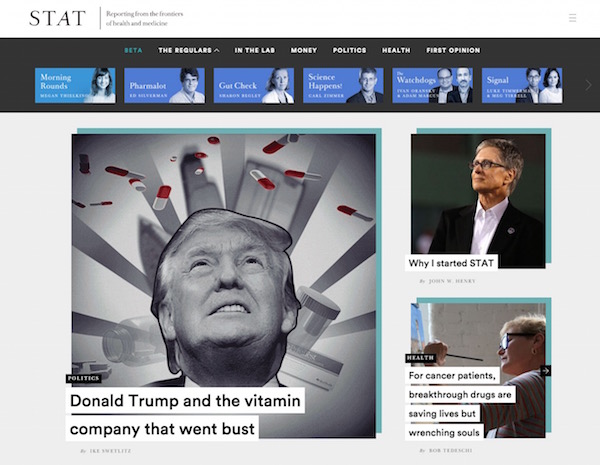
Building on The Globe’s long history of reporting on the Catholic Church — at a theater near you, this Friday! — and since the Boston metro area is still one of the most Catholic in the United States, the company last year launched Crux, a site dedicated to covering the faith.
But Crux is small potatoes compared to what Henry is launching today, its most ambitious standalone effort yet: Stat, a site focused on covering health and life sciences.

Rick Berke, the former New York Times editor, was hired earlier this year to lead Stat as editor-in-chief after his short stint as Politico’s executive editor. “I came the last week in February,” he said. “I was just sitting alone in an office in the Globe next to John Henry’s office for a long time just with a laptop.”
But Berke is far from alone now. Between the business and editorial sides, Stat has more than 50 staffers at launch — from reporters in bureaus in New York, Washington, and San Francisco to its own marketing, advertising, and audience development departments. That’s a sizable investment for a traditional media company in a new product; by contrast, Crux lists six staffers on its masthead. Unlike Crux, Stat is structured under its own separate company, Boston Life Science Media, but state filings still list Boston Globe Media Partners, the Globe’s parent company, as its manager.
“We see an opening,” Berke said. “On the one end of the scale, you have very high end publications like The New York Times and The New Yorker who do wonderful stories in these areas. Then you have more academic journals that do wonderful work, like the New England Journal of Medicine. And then you have hundreds of trade publications, and consumer publications like WebMD that appeal to the masses. What we don’t see is anywhere in the middle where there’s consistent energetic 24/7 news that’s really interesting, provocative journalism.”
The site is free to use and ad-supported, but Stat is looking to add paid products down the road. For now, the site’s main focus is to use its large staff to reach as wide an audience as possible on multiple mediums.
Berke said he emphasized hiring knowledgable, experienced reporters who could help bring their followings to Stat. For example, Pharmalot, a popular blog on the pharmaceutical industry run by Ed Silverman, is now being hosted on Stat after most recently being based at The Wall Street Journal. Stat also plans to emphasize video and multimedia coverage; it’s launching a podcast to accompany the site.Though Stat’s own site is only debuting this week, it’s been publishing stories on the Globe’s website since August. It’ll continue to share content with the Globe, and it’s in conversations with a number of other publications about potential content deals.
Stat claims some early success with its daily email newsletter, Morning Rounds, which it says has an open rate of 46 percent — though it wouldn’t say what size of subscriber pool that was based on. Stat hasn’t promoted the newsletter yet; for comparison, it has nearly 900 Facebook likes and 3,100 Twitter followers at launch.
The site wouldn’t share specific audience or revenue targets, but Stat chief revenue officer Angus Macaulay said the “objective is to get to profitability quickly.” One of the ways it will look to get there is though paid products. While everything Stat produces will be free for now, Macaulay said the site is considering a number of options for how it could charge readers to access specific content.
He said there are a number of different routes Stat could choose — such as a metered paywall, like the Globe, or separate subscription-only offerings like Politico Pro.
“The objective right now is to let people enjoy all of the content, and even down the road as we look at the paid products, there will always be an element for people to enjoy for free,” Macaulay said. “Obviously, there are brands who are having some success with it, and as a business it’s always better to work through multiple revenue streams. They don’t always need to be equal revenue streams, but it’s always a smarter strategy to have multiple revenue streams and have a product that people would find worthwhile to pay for.”
Stat also plans to develop an events program, and Berke said the site could at some point next year launch a print product. “We’re weighing different options, but that would be something distributed well beyond Boston,” he said. “You can gather from everything I’m saying that we see this is as a national, if not international publication.”
Despite its international ambitions, Stat is still dedicating resources to covering health science from a local angle as well. It has reporters dedicated to covering Kendall Square, the area of Cambridge that’s become a research hub due to its proximity to MIT, and Boston’s Longwood Medical Area, home to a number of hospitals and the Harvard Medical School.
Berke said much of what goes on there is relevant to audiences outside of Boston, but he hopes that a significant local readership — many of whom work in Kendall Square or Longwood — will also help Stat gain traction elsewhere.
“We see Kendall and Longwood being the epicenter of Boston, being the epicenter of what we’re doing, so in addition to the big breakthrough stories we want to cover them closely and aggressively.”